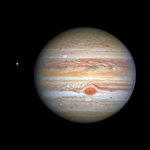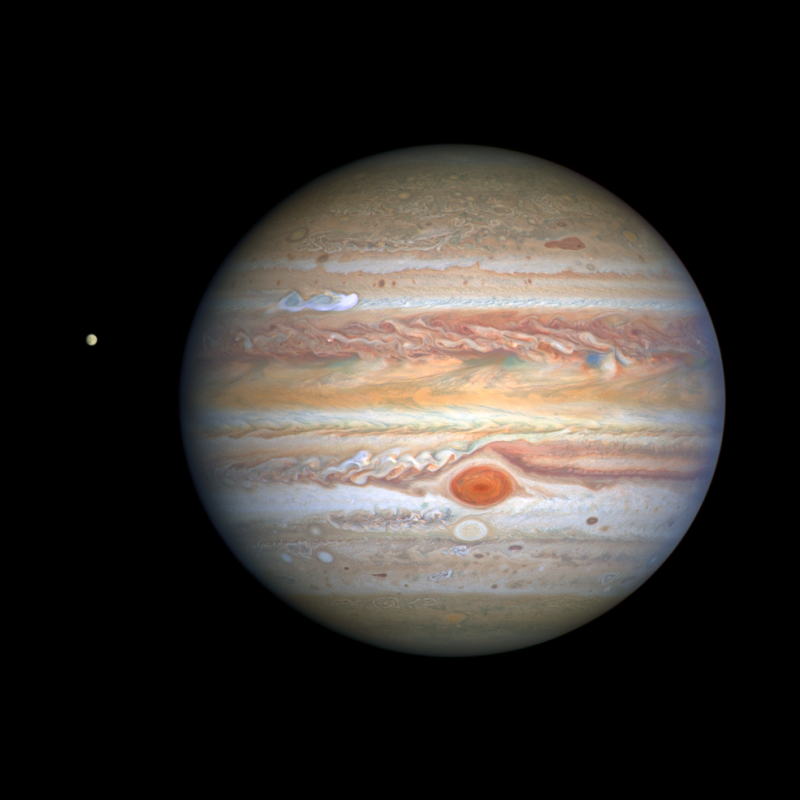

View larger. | This might not be the clearest image of Jupiter you’ve ever seen. Spacecraft images are clearer. But it is the clearest image taken from Earth we can recall. Isn’t it beautiful? It’s from the Hubble Space Telescope. The little moon to the left is Europa. Read below to learn about several famous storms of Jupiter, shown in this image. Image via NASA, ESA, STScI, A. Simon (Goddard Space Flight Center), M.H. Wong (University of California, Berkeley), and the OPAL team.
The Hubble Space Telescope captured this image of Jupiter on August 25, 2020, from a distance of 406 million miles (650 million km) from Earth. That wasn’t when Jupiter was closest to us this year. It was closest on July 15, a couple of days after Earth swept between Jupiter and the sun, as we do once each year. Still, in August, Jupiter and Earth were relatively close, in part accounting for the clarity of this image, which shows Jupter’s icy moon Europa (6th-closest of the planet’s 79 known moons) as well as some famous storms in Jupiter’s dense atmosphere.
There are lots of cool things to notice in this image.
First, notice Europa to the left of the planet. It’s the smallest of Jupiter’s four Galilean moons, and is thought to have an ocean beneath its icy surface, possibly holding the ingredients for life.
Now, look at the planet itself. You probably know that the bands we see aren’t on the planet’s surface; instead, when we look at Jupiter, we’re seeing only the uppermost layers of its clouds. The image shows the Great Red Spot, a great storm greater in diameter than our entire Earth, rolling counterclockwise in the atmosphere above Jupiter’s southern hemisphere. NASA said the Red Spot plows into the clouds ahead of it:
… forming a cascade of white and beige ribbons. The Great Red Spot is currently an exceptionally rich red color, with its core and outermost band appearing deeper red.
Researchers say the Great Red Spot now measures about 9,800 miles (14,500 km) across, big enough to swallow Earth. The super-storm is still shrinking as noted in telescopic observations dating back to 1930, but the reason for its dwindling size is a complete mystery.
Now … see the second oval spot below the Great Red Spot? It’s also a storm in Jupiter’s atmosphere, called Red Spot Jr. by scientists. This storm on Jupiter has a long history. NASA said:
Red Spot Jr. is the first storm that astronomers watched develop on a gas giant planet. The huge spot formed between 1998 and 2000, when three small, white, oval-shaped storms merged together. Two of the white spots have been observed since about 1915, but they may have been present even earlier. The third white spot appeared in 1939. In December 2005, the newly formed single white spot turned red, like the much older Great Red Spot.
And NASA also said:
For the past few years, Red Spot Jr. has been fading in color to its original shade of white after appearing red in 2006. However, now the core of this storm appears to be darkening slightly. This could hint that Red Spot Jr. is on its way to turning to a color more similar to its cousin once again.
Now look more closely at Jupiter’s cloud bands. Note the bright, white, stretched-out storm at mid-northern latitudes (to the upper left of the Great Red Spot and Red Spot Jr). You can see it more clearly in the image below.

View larger. | The Hubble Space Telescope captured this image of Jupiter in ultraviolet, visible, and near-infrared light on August 25, 2020. In this photo, the parts of Jupiter’s atmosphere that are at higher altitude, especially over the poles, look red from atmospheric particles absorbing ultraviolet light. Conversely, the blue-hued areas represent the ultraviolet light being reflected off the planet. Image via NASA, ESA, STScI, A. Simon (Goddard Space Flight Center), M.H. Wong (University of California, Berkeley), and the OPAL team https://ift.tt/35OUHgi
NASA said this bright white storm is:
… traveling around the planet at 350 miles (560 km) per hour. This single plume erupted on August 18, 2020 – and ground-based observers have discovered two more that appeared later at the same latitude.
While it’s common for storms to pop up in this region every six years or so, often with multiple storms at once, the timing of the Hubble observations is perfect for showing the structure in the wake of the disturbance, during the early stages of its evolution. Trailing behind the plume are small, rounded features with complex ‘red, white, and blue’ colors in Hubble’s ultraviolet, visible, and near-infrared light image. Such discrete features typically dissipate on Jupiter, leaving behind only changes in cloud colors and wind speeds, but a similar storm on Saturn led to a long-lasting vortex. The differences in the aftermaths of Jupiter and Saturn storms may be related to the contrasting water abundances in their atmospheres, since water vapor may govern the massive amount of stored-up energy that can be released by these storm eruptions.
Bottom line: A beautiful new image of Jupiter from the Hubble Space Telescope – captured in August 2020 – shows the planet’s icy moon Europa as well as several famous storms in Jupiter’s atmosphere.
from EarthSky https://ift.tt/33By38o


View larger. | This might not be the clearest image of Jupiter you’ve ever seen. Spacecraft images are clearer. But it is the clearest image taken from Earth we can recall. Isn’t it beautiful? It’s from the Hubble Space Telescope. The little moon to the left is Europa. Read below to learn about several famous storms of Jupiter, shown in this image. Image via NASA, ESA, STScI, A. Simon (Goddard Space Flight Center), M.H. Wong (University of California, Berkeley), and the OPAL team.
The Hubble Space Telescope captured this image of Jupiter on August 25, 2020, from a distance of 406 million miles (650 million km) from Earth. That wasn’t when Jupiter was closest to us this year. It was closest on July 15, a couple of days after Earth swept between Jupiter and the sun, as we do once each year. Still, in August, Jupiter and Earth were relatively close, in part accounting for the clarity of this image, which shows Jupter’s icy moon Europa (6th-closest of the planet’s 79 known moons) as well as some famous storms in Jupiter’s dense atmosphere.
There are lots of cool things to notice in this image.
First, notice Europa to the left of the planet. It’s the smallest of Jupiter’s four Galilean moons, and is thought to have an ocean beneath its icy surface, possibly holding the ingredients for life.
Now, look at the planet itself. You probably know that the bands we see aren’t on the planet’s surface; instead, when we look at Jupiter, we’re seeing only the uppermost layers of its clouds. The image shows the Great Red Spot, a great storm greater in diameter than our entire Earth, rolling counterclockwise in the atmosphere above Jupiter’s southern hemisphere. NASA said the Red Spot plows into the clouds ahead of it:
… forming a cascade of white and beige ribbons. The Great Red Spot is currently an exceptionally rich red color, with its core and outermost band appearing deeper red.
Researchers say the Great Red Spot now measures about 9,800 miles (14,500 km) across, big enough to swallow Earth. The super-storm is still shrinking as noted in telescopic observations dating back to 1930, but the reason for its dwindling size is a complete mystery.
Now … see the second oval spot below the Great Red Spot? It’s also a storm in Jupiter’s atmosphere, called Red Spot Jr. by scientists. This storm on Jupiter has a long history. NASA said:
Red Spot Jr. is the first storm that astronomers watched develop on a gas giant planet. The huge spot formed between 1998 and 2000, when three small, white, oval-shaped storms merged together. Two of the white spots have been observed since about 1915, but they may have been present even earlier. The third white spot appeared in 1939. In December 2005, the newly formed single white spot turned red, like the much older Great Red Spot.
And NASA also said:
For the past few years, Red Spot Jr. has been fading in color to its original shade of white after appearing red in 2006. However, now the core of this storm appears to be darkening slightly. This could hint that Red Spot Jr. is on its way to turning to a color more similar to its cousin once again.
Now look more closely at Jupiter’s cloud bands. Note the bright, white, stretched-out storm at mid-northern latitudes (to the upper left of the Great Red Spot and Red Spot Jr). You can see it more clearly in the image below.

View larger. | The Hubble Space Telescope captured this image of Jupiter in ultraviolet, visible, and near-infrared light on August 25, 2020. In this photo, the parts of Jupiter’s atmosphere that are at higher altitude, especially over the poles, look red from atmospheric particles absorbing ultraviolet light. Conversely, the blue-hued areas represent the ultraviolet light being reflected off the planet. Image via NASA, ESA, STScI, A. Simon (Goddard Space Flight Center), M.H. Wong (University of California, Berkeley), and the OPAL team https://ift.tt/35OUHgi
NASA said this bright white storm is:
… traveling around the planet at 350 miles (560 km) per hour. This single plume erupted on August 18, 2020 – and ground-based observers have discovered two more that appeared later at the same latitude.
While it’s common for storms to pop up in this region every six years or so, often with multiple storms at once, the timing of the Hubble observations is perfect for showing the structure in the wake of the disturbance, during the early stages of its evolution. Trailing behind the plume are small, rounded features with complex ‘red, white, and blue’ colors in Hubble’s ultraviolet, visible, and near-infrared light image. Such discrete features typically dissipate on Jupiter, leaving behind only changes in cloud colors and wind speeds, but a similar storm on Saturn led to a long-lasting vortex. The differences in the aftermaths of Jupiter and Saturn storms may be related to the contrasting water abundances in their atmospheres, since water vapor may govern the massive amount of stored-up energy that can be released by these storm eruptions.
Bottom line: A beautiful new image of Jupiter from the Hubble Space Telescope – captured in August 2020 – shows the planet’s icy moon Europa as well as several famous storms in Jupiter’s atmosphere.
from EarthSky https://ift.tt/33By38o

Aucun commentaire:
Enregistrer un commentaire